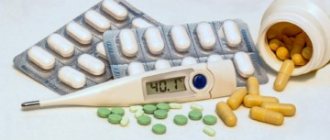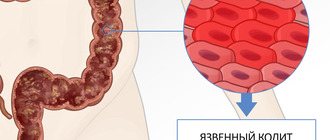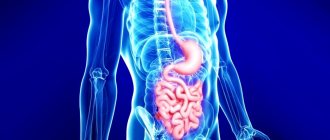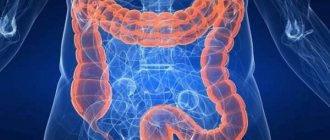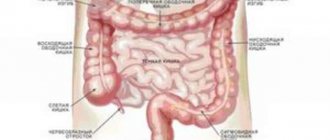Structure of the human intestine
In the body, the intestines originate from the pylorus of the stomach - the sphincter, which controls the flow of processed food directly into the intestines. Ends with the anal opening. Conventionally, the intestine can be divided into two main parts - the large and small intestine. Each of them has several sections that perform specific functions in the process of human digestion. The intestinal walls consist of 4 membranes: 1. Mucosa, which, in turn, has three layers: epithelial, lamina with liberkühn glands and muscular lamina. 2. Submucosa, consisting of connective tissue, blood vessels and nerves. 3. Muscular membrane. 4. Serous, consisting of dense connective tissue with squamous epithelium on the outside.
Small intestine and its parts
The small intestine is the “beginning” of the intestine, located between the stomach and large intestine. It was called thin because of its smaller lumen diameter and wall thickness compared to the large intestine. In fact, most of the entire digestion process takes place in the small intestine. Here nutrients are absorbed from food digested in the stomach. Sections of the small intestine: • duodenum; • jejunum; • ileum.
The duodenum is the first part of the intestine after the stomach. It connects with it at the location of the pylorus of the stomach. This section of the small intestine is nicknamed because it is approximately 12 fingers long (the width of 12 fingers). The duodenum has its own division into upper, descending, horizontal and ascending parts. Its shape and position are not the same in different people and depend on many factors, such as age or body type. There is another, unofficial name for the duodenum - “pituitary gland of the digestive system.” The explanation for this lies in its location. It is located between the stomach, most of the intestines and the liver, and plays the role of coordinator of the entire human digestive system. The pituitary gland works in a similar way, but with different body systems. The jejunum is the center of the small intestine. From an anatomical point of view, it differs little from the ileum and, in fact, the second is a continuation of the first. The only difference is that the jejunum is noticeably less vascular, has a smaller diameter and thinner walls. The ileum is the source of the production of the hormonal substance neurotensin. Neurotensin activates various processes in the digestive organs necessary for proper digestion of food.
Large intestine and its parts
Unlike the small intestine, in which the absorption of all useful substances from food digested by the stomach occurs, the large intestine in the human body is responsible for the absorption of water and the formation of feces. It is represented by: • the cecum; • colon; • rectum.
Each department has its own constituent parts. The cecum is a kind of appendage located where the small intestine “turns” into the large intestine. Undigested food remains are “dumped” into this temporary storage, from where they then move to other parts of the colon. Unloved by many for its ability to become inflamed at the wrong moment, the appendix is an appendage of the cecum, scientifically called the vermiform appendix. With an average length of only 7-10 cm, the appendix is present only in humans and some species of mammals. The colon is a section that is a continuation of the cecum. In fact, it is the colon, which includes such parts as the ascending colon, transverse colon, descending colon and sigmoid colon, that is the main section of the large intestine. This part of the intestine no longer takes part directly in digestion. What remains of food during the processing stage in the small intestine enters here in a relatively liquid form. Remaining water and electrolytes are absorbed. The remaining material is converted into feces. The rectum is the end of the intestines and the entire human digestive tract. It does not have pronounced bends compared to other segments of the human intestine and continues all the way to the anus. Its upper part is called the rectal ampulla, the lower part is called the anal canal. The processes of fecal formation are completed in the rectum.
Small intestine
Immediately after the end of the duodenum, sections of the small intestine join it, the first of which is the jejunum, and then it smoothly passes into the ileum. Thus, this department consists of two parts. The length of the human small intestine, including all its sections, ranges from 5 to 7 meters. The processes of digestion and absorption of nutrients occur in it. Energy exchange occurs by transferring nutrients and microelements through the walls into the blood. The walls of the small intestine secrete special enzymes called enterocytes, which are capable of breaking down food into simple amino acids and glucose from fatty acids. Subsequently, through absorption into the intestinal mucosa, these substances enter the body. Glucose and amino acids are transmitted through the blood. Fatty acids, in turn, enter the lymphatic capillaries, passing through them to the liver.
The small intestine is very important for humans and, despite the fact that the entire intestinal system is long, it is precisely without this section that a person cannot exist. The bauhinium valve is located between the small and large intestines. It is a muscle fold and serves to prevent the movement of feces from the large intestine back to the small intestine.
The human small intestine has connecting fasteners of various widths and shapes, ensuring the position of the intestine and its rounded loops, as well as its fixation. With their help, it is fixed to the posterior abdominal wall. The small intestine contains a lot of blood and lymphatic vessels, as well as nerve endings.
Functions of the intestines in the human body
In short, the human intestine is busy absorbing nutrients from food digested by the stomach into the blood. We are talking about already simplified substances, and those that turn out to be superfluous leave the body in the form of feces and intestinal gases. All these processes are supported by a huge number of bacteria that form the microflora of the human intestine. Thus, this part of the digestive system works as the final squeeze of everything useful and necessary for the human body from food, plus the discharge of waste. But in fact, the intestines have other, equally important functions. The intestines are one of the most important parts of the immune system. This is a serious barrier to pathogens trying to attack the human body. Microbes that penetrate through the gastrointestinal tract (GIT) somehow end up in the intestines. To start reproducing here they need to “secure a place for themselves.” However, the human intestine is already richly populated with its own bacteria, which will not allow the “alien” to cling to the intestinal walls. They block any attempts of foreign microorganisms to begin to multiply, after which immunity in the form of antibodies destroys the threat. Healthy microflora not only protects the body from infections, but also promotes proper digestion.
Composition of intestinal microflora
Bacteria of the human intestine are: • lactobacilli, bifidobacteria, bacteroides (belong to the main group); • enterococci and various strains of Escherichia coli (related group); • Proteus, staphylococci (final group).
The latter also include microorganisms from the kingdom Fungi. Normally, all of the listed species inhabit the human colon. In addition to them, some other types of microorganisms are found in the intestines. All of them live in symbiosis with the host, that is, they benefit from such an existence, giving them the properties necessary for humans. Interesting fact: the intestines of one healthy person are home to approximately 50 trillion microorganisms, which is approximately 70 times the number of people on Earth and 1.3 times more than the number of cells in the human body. More than half of all feces consists of dead bacteria. All microorganisms of the intestinal microflora are divided into anaerobes and aerobes, that is, those that do not need and those that require oxygen, respectively. The vast majority of intestinal bacteria are anaerobes (over 95%). These are bifidobacteria, lactobacilli and bacteroides. Aerobes include, for example, E. coli and enterococci. It is worth highlighting the type of symbiotic relationship between intestinal bacteria and the human body itself. This is not a completely harmless coexistence, but mutualism. In such a relationship, both parties receive some benefit from the proximity. Bacteria perform their beneficial functions, and the intestines provide them with a place to live and reproduce. Like any other microorganisms, the inhabitants of the human intestine are prone to an uncontrolled increase in their numbers. This is prevented by such “safeties” as the secretion of hydrochloric acid, the ileocecal valve, which blocks the entry of bacteria from the large intestine into the small intestine, and the function of pushing contents from the small intestine into the large intestine. Hydrochloric acid prevents bacteria from multiplying in the upper gastrointestinal tract. Disturbances in the functioning of the intestines can be caused by either an exaggeration of the volume of a certain type of bacteria or extinction.
Colon Anatomy
The following sections of the large intestine are distinguished:
The ascending colon forms a right hepatic bend at a right angle, less often at an acute angle, in the upper right region of the abdomen as it passes into the transverse colon. The right bend is in contact with the lower surface of the liver and the bottom of the gallbladder.
The transverse colon has a length of 25 to 62 cm and a mesentery of 12 cm. The transverse intestine hanging down can be located in the small pelvis and become the contents of the hernial sac, even with inguinal and femoral hernias.
In the left upper region of the abdomen there is the left splenic flexure at the transition of the transverse colon to the descending colon. It forms an acute angle.
Common bowel disorders
The human intestine is a unique organ. Despite the fact that its functional component is strong, it is not at all difficult to cause disturbances in the intestines. Many people have the erroneous impression of this organ as a system for processing any waste: whatever you put into it, it will process everything and remove it outside the body. This is partly true, but the rich microflora is easily destroyed, leading to various disorders in the intestines. When this most important part of the digestive system malfunctions, symptoms such as problems with bowel movements, pain in the lower abdomen, and false urge to stool (tenesmus) appear. Symptoms of intestinal dysfunction can even include headaches, excessive sweating, weakness, malaise and breathing problems. Very often, skin diseases indicate improper functioning of the intestines. The clearest example is acne, which indicates intestinal slagging. Below is a list of common symptoms and associated bowel problems. Of course, any of the symptoms described only approximately indicates a specific disorder. A more precise reason can only be determined by undergoing an examination under the supervision of a doctor. You shouldn't joke with your intestines: even banal constipation can be the result of very serious problems that require immediate medical intervention. Constipation is a symptom of poor nutrition, often deprived of the required amount of plant foods (fiber). In addition, the cause of constipation can be the sedentary lifestyle that is widespread today. Constipation may indicate the presence of intestinal adhesions, or tumors of the uterus or appendages in women. By the way, constipation often occurs during menopause, and the reasons can be psychological. Neurogenic constipation is a common phenomenon. Some people cannot go to the toilet while traveling on a train; others find it difficult to do so in uncomfortable temporary living conditions (camps, sanatoriums). It is worth noting that stool 3 times a day to 3 times a week is the norm if a person does not experience physical and emotional discomfort. Stool retention in combination with flatulence may indicate gynecological peritonitis. Tenesmus is an unpleasant condition that represents a false urge to defecate, usually painful, with a very small volume of feces or almost no stool. It may accompany dysentery or cholera, although in some cases it appears after radiotherapy and x-ray therapy of the genital organs. Diarrhea is a frequent and liquid stupa, the causes of which can be intestinal infections, but sometimes diarrhea can indicate much more dangerous problems, such as intestinal tuberculosis or parametritis. Various types of pain: pain during bowel movements is a signal of the presence of hemorrhoids or paraproctitis. In women, such pain can occur due to inflammation in the area of the peri-uterine and peri-vaginal tissue. If the pain does not stop the rest of the time, this may indicate cancer of the rectum or genital organs. In women, pain extending into the rectum may indicate an ectopic pregnancy. Loss of appetite or its complete disappearance is a symptom of exacerbation of chronic intestinal diseases. Systematic disturbances in the functioning of the intestines are a reason to immediately visit a general practitioner, who, based on an initial study, sends the patient to a gastroenterologist, proctologist or nutritionist, depending on the type of problem detected.
Causes
The range of reasons that can cause disruption of the large intestine is quite wide. The most common factors include:
- Infectious agents. Under the influence of bacterial and viral agents, an inflammatory reaction develops in the wall of the organ, which underlies a group of intestinal diseases - colitis.
- Autoimmune processes. Aggression of a person’s own immunity towards the wall of the large intestine also contributes to the occurrence of inflammatory processes. This development mechanism is characteristic of one of the most severe diseases of the large intestine - nonspecific ulcerative colitis.
- Allergic reactions. When a product to which the patient is allergic enters the digestive system, an active hypersensitivity reaction develops. This process occurs with food allergies.
- Toxic effects. When the intestinal wall is damaged by toxic substances, the normal functioning of the organ is disrupted and symptoms of its damage appear.
- Vascular disorders. With insufficient blood supply to the organ, ischemia of the large intestine develops - oxygen deficiency and hypoxia accompanying this process. Vascular disorders occur with ischemic colitis.
- Dysbacteriosis. The lack of normal microflora in the large intestine adversely affects many areas of metabolism. With a decrease in the content of symbiont bacteria, the risk of intestinal infection by pathogenic microorganisms increases. In addition, the body experiences a deficiency of those vitamins that are normally produced by the “friendly” intestinal microflora.
- Oncological processes. Tumors can occur in the intestinal wall and tend to progress rapidly. These can be both benign formations (polyps) and malignant tumors (intestinal cancer).
- Lifestyle disorder. The appearance of intestinal diseases is facilitated by features of the daily routine - poor diet, inadequate sleep, insufficient physical activity. These disorders cannot cause the disease on their own, but they help reduce the body’s immunity, that is, they have an indirect effect.
- Helminthic infestations. Some parasites live in the large intestine, which leads to digestive problems. With a prolonged course of helminthiasis, it is possible to develop general metabolic disorders caused by insufficient absorption of nutrients in the area of parasite invasion.
We recommend reading:
Hemocolitis in children: causes, symptoms and treatment (nutrition, medications)
The genetic factor has a certain significance in the development of diseases of the large intestine. Some pathologies are characterized by a hereditary predisposition, which increases the risk of developing diseases of the digestive system.
Bowel diseases
Causes
There is a large list of diseases characteristic of the human intestine and six main ways of their occurrence: 1. Infections 2. Parasites 3. Poor lifestyle 4. Genetic factors 5. Taking medications 6. Malfunctions of the immune system
And if in most cases banal precautions and hygiene rules protect against the first two points, then no one is safe from the third. An unhealthy lifestyle means the presence of bad habits (smoking), low mobility, stress, and poor nutrition. Of course, you can quit smoking or not start at all; it’s not difficult to force yourself to eat right. It is more difficult to escape sedentary work or constant nervousness. According to some data, people who work sitting for many years are at increased risk of developing bowel cancer. The fourth item on the list is genetic predisposition. For example, this cause, along with immune deficiency, is often cited for ulcerative colitis, a common disease that manifests itself as inflammation of the intestinal lining. Long-term use of medications (5th point), namely antibiotics, can destroy intestinal microflora. As a result of the death of a large number of, for example, bifidobacteria, dysbacteriosis develops. The last point is interconnected with the first two: when the immune defense is weakened, foreign bacteria and parasites become more easily established in the human intestines.
Human intestinal diseases
The list of diseases that affect the human intestine is long. The most common infectious diseases: • dysentery; • amoebiasis; • cholera; • typhoid fever.
All of them are caused by different types of bacteria and amoebas. You can become infected with any of these diseases simply by not washing your hands before eating. It would seem that an intestinal infection, at best, results in many hours of torment, accompanied by diarrhea and vomiting, but what about the worst? The statistics are as follows: over the course of a year, tens of millions of people fall ill with various types of dysentery and from 1% to 9% die. Of course, deaths occur due to the lack of qualified medical care, which is typical in poor countries. For example, more than 9.5 thousand people died from cholera in Haiti in 2020, which is a decent proportion of the country's population. There are frequent epidemics of intestinal infections around the world. There are also more dangerous infectious diseases: • intestinal tuberculosis, the source of which is Mycobacterium tuberculosis; • intestinal syphilis is a rare form of sexually transmitted disease.
Parasitic intestinal diseases are: • ascariasis; • trichinosis; • intestinal myiases; • hookworm; • trichocephalosis; • scarabiasis;
and others. What these diseases have in common is that they represent intestinal damage by parasites of various species. For example, a very unpleasant disease, which, according to various estimates, affects from 800 million to 1.2 billion people, is ascariasis. The majority of carriers of the roundworm parasite live in poor developing countries. The size of an adult worm can reach 30 centimeters. It parasitizes the small intestine, and parasite eggs enter the body through unwashed fruits and vegetables. The symptoms of ascariasis are complex enough to use some symptoms to diagnose the presence of the parasite in the body. A full medical examination is required, including blood and stool tests. Symptoms include a slight increase in body temperature over a long period of time, allergic reactions, abdominal pain, nausea, and itching in the anus. Some parasitic intestinal diseases are not caused by worms. For example, the source of intestinal myiases is the larvae of flies, including the most common house flies, and scarabiasis even comes from beetles that penetrate the anus while a person is sleeping. Fortunately, this disease occurs only in the Southern Hemisphere, but avid travelers should know about it.
Other common bowel diseases
In addition to infectious and parasitic diseases, inflammatory diseases are often encountered: • ulcerative colitis; • Crohn's disease; • ischemic colitis; • colitis caused by microflora disturbances due to the use of antibiotics.
For example, ulcerative colitis, or an immune-mediated inflammation of the intestinal lining, affects the colon. The exact causes of the disease have not yet been clarified. It is often “passed on” from relatives (genetic predisposition). Likewise, your chances of getting Crohn's disease increase. Separately, it is worth mentioning intestinal tumors, which, by the way, can be caused by poor nutrition, and irritable bowel syndrome, which is various disturbances in the functioning of this organ without obvious causes.
Common pathologies of the large intestine
The most common diseases affecting the large intestine are:
Colon dyskinesia
It is also called “irritable colon”, “mucosal colitis”. The pathology manifests itself as periodic attacks of bloating, rumbling in the abdomen, and pain in the abdomen, usually relieved by defecation. Attacks occur after an error in diet or stress. When examining, no changes in the digestive canal are detected, since the basis of the disease is a violation of the nervous regulation of its work.
Diverticulosis
Diverticula are sac-like protrusions of the intestinal wall in the direction opposite to its lumen. They occur in people who prefer food poor in plant fibers and fiber. Most often, diverticula begin to appear only in old age or senility. Their “favorite” localization is the left sections of the intestine.
The disease does not manifest itself in anything special for a long time. Occasionally, abdominal pain and constipation may occur. The appearance of symptoms is associated with complications of diverticulosis: diverticulitis (inflammation of the protrusion), the occurrence of ulcers and suppurations in the diverticula. This is manifested by persistent abdominal pain, vomiting, weakness, fever, pain when touching the abdomen. This clinical picture suggests that surgical intervention is required.
Chronic colitis
This disease can occur after suffering from dysentery; it can be caused by worms and protozoa such as Giardia. Chronic colitis can develop as a result of chronic poisoning with salts of heavy metals, and also become a “response” to taking allergenic foods.
Symptoms are nonspecific and occur in attacks:
- stomach ache;
- bloating;
- the urge to defecate, after which the bowel movement itself does not occur;
- diarrhea, which is replaced by constipation;
- nausea;
- mucus and streaks of blood are found in the stool;
- weight loss;
- decreased appetite;
- irritability;
- insomnia;
- headache.
Nonspecific ulcerative colitis
This is a disease whose cause has not yet been determined. The most common theory considers bacteria to be the main “culprit” for the appearance of ulcers on the mucous membrane of the colon. It is confirmed in treatment: taking specific antibiotics can significantly improve a person’s condition.
UC appears:
- bleeding of scarlet blood from the rectum;
- periodic diarrhea;
- severe pain in the left half (maybe in the right) of the abdomen;
- decreased performance;
- weakness.
Ulcerative colitis can become a precancerous disease, as well as a cause of intestinal contents entering the abdominal cavity, so it must be “kept under control” with medication, checking the condition of the ulcers by endoscopic methods (sigmoidoscopy, colonoscopy) every 6-12 months.
Crohn's disease
With this pathology, there is the appearance of areas of inflammation in any part of the gastrointestinal tract, from the esophagus to the sigmoid colon. In this case, all the membranes of the “digestive tube” are affected.
The first symptoms of this intestinal disease:
- pain in the abdomen, usually in the right side, reminiscent of an attack of appendicitis;
- bloating;
- diarrhea;
- increased body temperature;
- rumbling in the stomach.
If the swelling of the intestinal wall is so significant that it blocks the lumen of the digestive canal, partial or complete intestinal obstruction develops, which is manifested by bloating, cessation of gas discharge, and vomiting. At first there may be stool, then it stops and becomes impossible.
When Crohn's disease persists for a long time, a person's joints often hurt and become swollen, pain begins on the right side under the rib, and red spots appear on the skin similar to an allergic rash.
Colon cancer
This disease develops quite often. Risk factors for its development are considered to be a diet rich in animal fats, flour foods and foods without fiber, alcohol intake, stress and trauma to the mucous membranes from foreign objects. The “culprit” is also the long-term existence without treatment of intestinal polyposis, ulcerative colitis, when the cells of the lining of the intestinal gastrointestinal tract, modified as a result of chronic inflammation, have to transform even more, becoming little similar to those that should be in this localization.
Signs of colon cancer are:
- constipation, especially if the tumor grows inside the intestinal canal;
- stomach ache;
- the appearance of blood in the stool, although there does not have to be a lot of it; single blood streaks are sufficient for examination;
- increase in temperature, usually to small numbers;
- weight loss;
- periodic diarrhea;
- weakness.
In the early stages, the disease is “silent”; it can only be detected if you undergo annual preventive endoscopic examinations.
Other diseases
The large intestine can become a localization for the development of such surgical diseases as:
- papillitis;
- paraproctitis;
- cryptite;
- anal fissures;
- haemorrhoids;
- rectal polyposis;
- rectal condylomatosis;
- epithelial coccygeal duct and its cyst.
Prevention and treatment of intestinal diseases
The only prevention of infectious and parasitic diseases is washing your hands with soap before eating and after visiting public places. It is necessary to thoroughly wash vegetables and fruits using detergents, even if they have peels. Basic rules of hygiene, learned from school, save you from most sources of intestinal infections and parasites. Thermal processing of food and the exclusion of contact between prepared and raw foods is important. Another important aspect of prevention is a healthy lifestyle, giving up bad habits, proper nutrition, rich in plant foods and dairy products, playing sports, striving for mobility and giving up the habit of sitting for hours in one place. The main difficulty in timely treatment of intestinal problems is that people experiencing constipation, diarrhea, increased gas production and other symptoms of gastrointestinal disorders and diseases do not rush to see a doctor. The vast majority of potential gastroenterologist patients try to “cure” on their own, resorting to the help of kefir. But by seeking qualified medical help in time, you can significantly reduce the risks of complications and the development of severe intestinal diseases. Therefore, at the first symptoms, do not be lazy to go to the doctor, no matter how delicate the problem.


